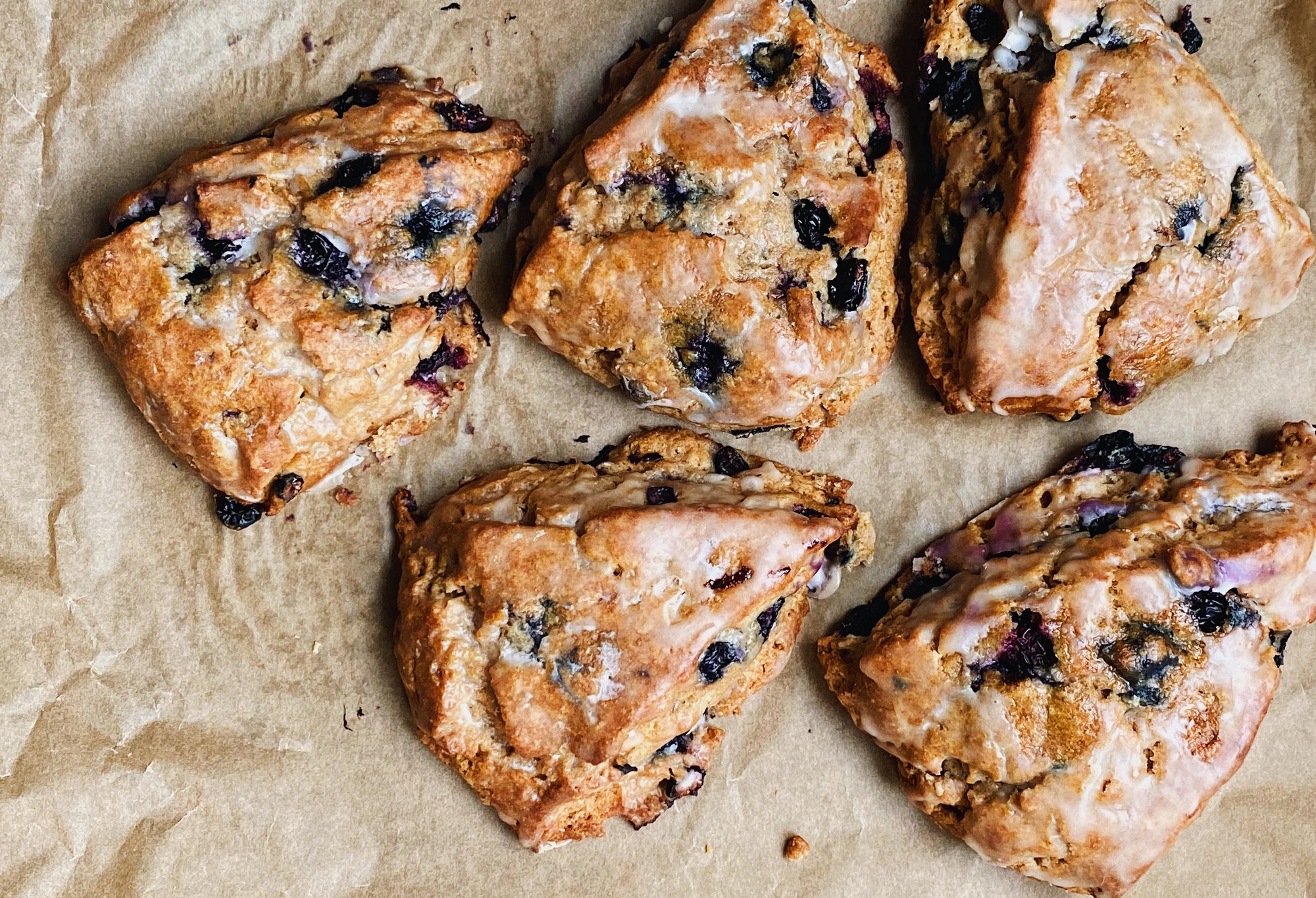We love the flavour and toothsome chew that whole grain flours add to baked goods, we used both whole grain and sifted flours in this recipe. Incorporating crème fraîche keeps the scones moist and decadent, and can be substituted with sour cream with similar results.
Maple Blueberry Scones
~ adapted from Flour
1 2/3 cups (220 g) Flourist Whole Grain Spelt Flour
1 cup (130 g) Flourist Sifted Red Fife Wheat Flour
1 1/2 tsp baking powder
1/2 tsp baking soda
1/2 tsp salt
3/4 cups (170 g) butter, cold and cubed
1/2 cup (120 g) crème fraîche, room temperature
1/2 cup maple syrup
1/3 cup buttermilk, room temperature
1 egg yolk, room temperature
1 1/2 cup (210 g) fresh blueberries
Glaze
1/2 cup (60 g) confectioner's sugar
2-6 tbsp maple syrup
In a mixing bowl of a standing mixer with the paddle attachment, combine flours, baking powder, baking soda and salt on low speed. Add half of the cubed butter and mix until fully incorporated, about 3 minutes.
Add the remaining butter to the bowl by flattening the cubes between your fingers to create flat sheets. Pulse the mixer three or four times to coat the butter in flour but keeping the pieces whole.
In a medium bowl, whisk together crème fraîche, maple syrup, buttermilk and egg yolk. Gently stir in the blueberries and pour the liquid into the dry ingredients with the mixer on low speed. Mix for about 10 seconds. Remove the bowl from the stand mixer and continue mixing by hand, gathering and turning the dough over gently until all of the flour is incorporated. Shape the dough into a large circle, 1 1/2" thick. Wrap well in plastic wrap and let rest in the refrigerator for at least 1 hour or overnight.
Preheat the oven to 350°F and line a baking sheet with parchment paper.
Unwrap the dough and cut into 8 wedges, place on a baking sheet a few inches apart (they will spread). Bake scones for 35-45 minutes, rotating the baking sheet halfway until the scones are firm and deep golden brown.
To make the glaze mix the confectioner's sugar in a small bowl and gradually add maple syrup and whisk together until a thick glaze forms. Using a pastry brush, apply the glaze onto the scones while they are still warm. Serve warm or at room temperature.



Comments
Made per instructions, except used some whole-milk kefir instead of buttermilk b/c that is what i had. Once chilled, i found the dough easy to work, and scones were delicious! On my make-again list, next year’s blueberry season!
Can whole grain Einkorn flour be substituted for your current flour blend? Would it be cup for cup?
Excellent, well-written recipe that yielded superb taste, crusty exterior and a yummy moist interior — a keeper! In my wife’s opinion, this is the BEST SCONE SHE’S EVER TASTED (and I agree)! Thank you for sharing!!!
Here’s some thoughts that might be useful to you and others:
I don’t have a stand mixer, so used a pastry cutter then fingers to add the butter to the flours. Whole wheat was substituted for the spelt flour, and it was sifted along with the red fife and other dry ingredients, before adding the wet ingredients. Lacking the foresight to make crème fraîche, I substituted sour cream. I also cut the chilled dough into 12 generous portions (8 seemed overly-generous) before baking — 40 minutes in the oven at 350F.
For people like me who are interested in nutrition, my rough calculations reveal that each of the 12 resulting 87g servings delivers 308 kcal of energy, 43 g of carbs (4 g fiber, 20 g sugars), 14 g of fat, and 5 g of protein — as well as a burst of true pleasure and happiness!
Next time, I’ll plan ahead and have the spelt and crème fraîche on hand, and perhaps add a bit of chia seed to the mix as well.
Just to follow up – the chill worked a bit and while sticky to start they baked up great and were SO DELICIOUS! :D
Similar to Sarah maybe – my batter was not runny but quite wet/sticky, more like a muffin batter. I’ve put it in the fridge in the bowl to hopefully firm up before trying to get it into a circle.
Hi Sue! You can use all Sifted Red Fife Flour if you like, but if you have a whole grain flour, any one would do to replace the spelt with the exception of rye flour. I hope that helps!
What could I use as a substitute for Spelt Flour, as I don’t have this one…..thanks
Lynne, great tip about the pastry cutter or two knives instead of a stand mixer!
Hi Chris! We love using discard in recipes too! It’s great for muffins, pancakes and we think you could certainly experiment with it in this scone recipe. You can find more recipes with sourdough starter discard here – https://flourist.com/search?q=starter. Happy baking!
Hi Sarah! The batter shouldn’t be very runny, it should be similar to pastry dough and form a ball fairly easily. Did you make any adjustments to the recipe? If only sifted flour was used for example, the batter could be more wet because whole grain flour absorbs more liquid.